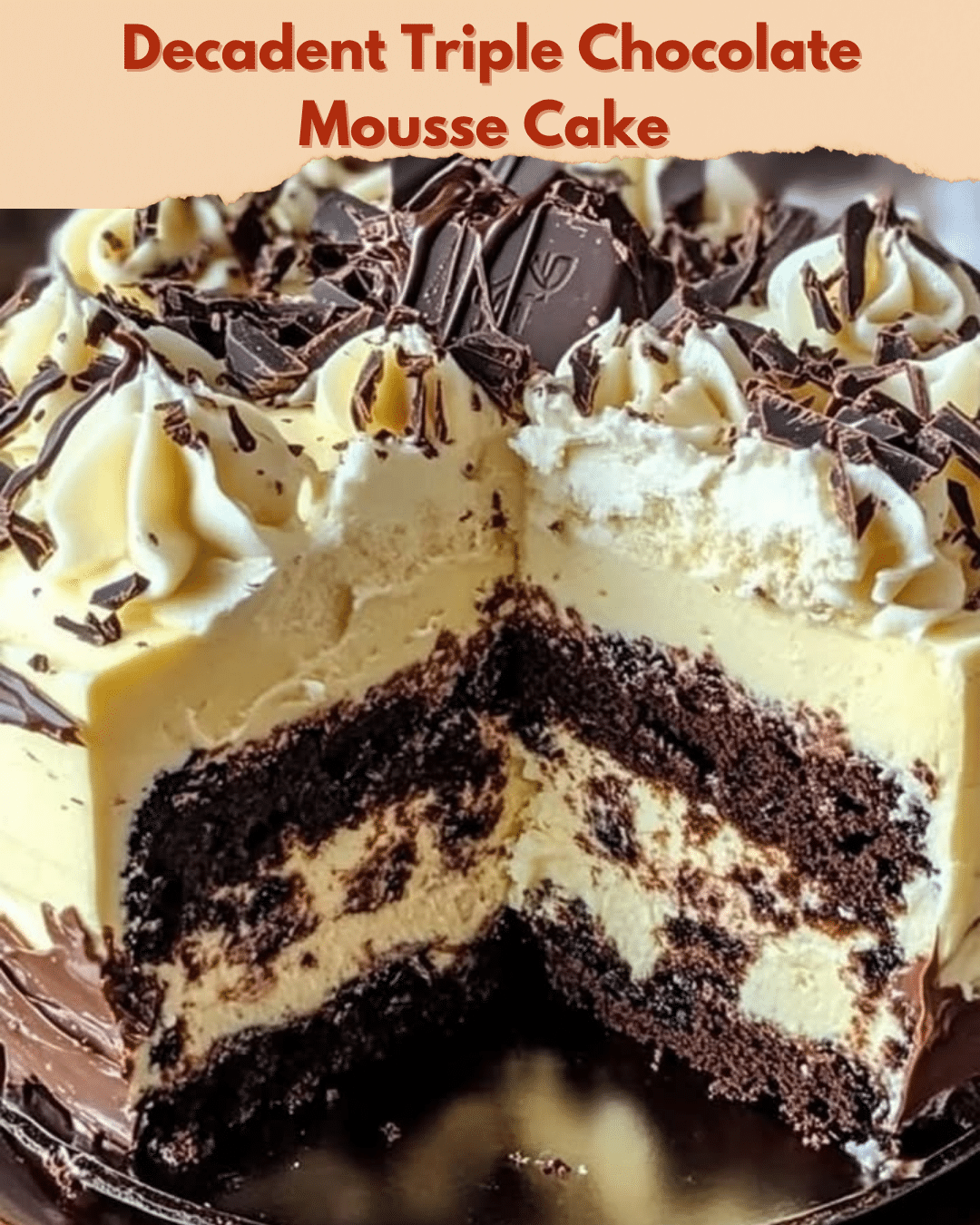Decadent Triple Chocolate Mousse Cake: Indulgence Redefined
The Decadent Triple Chocolate Mousse Cake is a chocolate lover’s dream come true. With its rich layers of chocolate sponge, creamy mousse, and velvety ganache, this cake is the epitome of indulgence. Each bite offers a burst of intense cocoa flavor, delightfully complemented by the decadent mousse. It’s a dessert that promises to impress any guest and elevate your dessert game to new heights.
Imagine sinking your fork into this sumptuous cake, feeling the soft texture of the mousse followed by the slight bite of the sponge. The interplay of textures is as captivating as the taste itself. The rich chocolate aroma fills the room as soon as you cut into the cake, making it an irresistible centerpiece for any special occasion.
Quick Recipe Highlights
Flavor Profile: This cake uses three different types of chocolate to create a symphony of cocoa flavors. The dark chocolate provides depth, milk chocolate adds sweetness, and white chocolate balances the palate with its creamy notes.
Texture: With layers ranging from soft and airy mousse to a spongy cake base and smooth ganache topping, this dessert offers an exquisite array of textures that melt in the mouth.
Aroma: The fragrance of rich chocolate is complemented by hints of vanilla and coffee, creating an aromatic delight that captures attention from the moment it’s served.
Visual Appeal: Presented with glossy ganache and delicate chocolate shavings, this cake is an alluring showstopper, perfect for elegant gatherings.
Skill Level Needed: This recipe requires advanced baking skills, including expertise in making mousse and handling ganache. Precision and patience are key components to achieving the perfect result.
Special Equipment: A springform pan and a stand mixer will be your best allies in achieving the desired texture and presentation for this cake.
Recipe Overview
Difficulty Level: The Decadent Triple Chocolate Mousse Cake is categorized as advanced due to its layered construction and the techniques involved in making mousse and ganache. Accurate temperature control and timing are crucial to mastering this cake.
Category: This dessert falls under the categories of celebration and gourmet baking, making it ideal for special occasions where presentation and taste are paramount.
Cuisine: This cake draws inspiration from European patisserie traditions, where chocolate is celebrated in luxurious tiers, and mousse cakes are a professional standard.
Cost: The ingredients, though slightly pricier due to the use of quality chocolates, are a worthy investment for the unforgettable experience this cake delivers.
Season: While perfect for all-year indulgence, this cake shines during winter months and festive seasons, offering warmth and comfort through its rich flavor.
Occasion: Ideal for birthdays, anniversaries, or any celebration that calls for a touch of class and decadence.
Why You’ll Love This Recipe
The taste of this Decadent Triple Chocolate Mousse Cake is unmatched with its balance of bitter, sweet, and creamy notes from each chocolate layer. The contrasting textures bring sensory delight with every mouthful.
Despite its complexity, this cake can be made in stages, making it feasible to prepare for those with busy schedules. The separation of components allows for time-efficient baking.
Though indulgent, you can adapt this cake to include dark chocolate with a higher cocoa percentage, maximizing antioxidants and making it a more health-conscious choice.
This cake brings people together. It’s a natural showpiece, prompting admiration and sparking conversation, making your hosting experience seamless and enjoyable.
Despite the premium ingredients, this cake is cost-effective when considering how many servings it yields and the satisfaction it delivers, replicating a high patisserie experience at home.
Historical Background and Cultural Significance
Originating from the luxurious kitchens of Europe, mousse cakes like this Decadent Triple Chocolate Mousse Cake gained popularity in the mid-20th century as chefs explored new techniques with cream and chocolate.
The cultural significance of chocolate mousse cakes lies in their presentation as a symbol of refinement and culinary expertise. They are often the centerpiece of extravagant dessert tables during European celebrations.
Over the years, the recipe has evolved, with chefs experimenting with flavored mousses and varying chocolate types, expanding its versatility to suit different tastes and occasions.
Regionally, mousse cakes vary widely. Some European chefs incorporate local flavors like hazelnuts or berries, while others keep it traditional with multiple layers of pure chocolate decadence.
Ingredient Deep Dive
Chocolate: The star ingredient, chocolate offers both cultural significance as a luxurious commodity and nutritional benefits like antioxidants. Choose the highest quality chocolate for the richest flavor; store in a cool, dry place to maintain its integrity.
Cream: Providing the base for the mousse, cream is crucial for the cake’s texture. Fresh cream brings richness and mouthfeel. Ensure it’s well-chilled for whipping, and opt for heavy cream for the best structure.
Eggs: Fundamental for mousse stability, eggs add silkiness and structure. Look for fresh, free-range eggs, and store them in the refrigerator. If you need a substitute, consider aquafaba for a plant-based option.
Gelatin: Essential for setting the mousse, gelatin gives the cake its form. For alternatives, agar-agar can be used, although the texture may slightly differ. Store gelatin in a dry place, away from light.
Butter: Used for flavor and texture, especially in the bake phase, butter should always be unsalted and at room temperature when needed. Clarified butter is an option for those looking for a clearer flavor.
Common Mistakes to Avoid
1. Overwhipping the cream causes it to separate and become butter-like. Whip until soft peaks, then gently incorporate.
2. Incorrect temperature when melting chocolate could seize it. Melt over a gentle heat and avoid any moisture contact.
3. Allowing the mousse to set at warm temperatures can prevent it from firming up properly. Refrigerate immediately after assembly.
4. Inadequate folding technique can deflate the mousse. Use a gentle hand and a large spatula to preserve airiness.
5. Ineffective demolding can ruin presentation. Use a hot knife or blow torch to loosen the sides before removing the springform pan.
6. Not chilling long enough can result in a lack of structure. It’s crucial to respect chilling times for firm layers.
7. Underestimating ingredient temperatures, especially with eggs, can disrupt consistency. Allow them to acclimate to room temperature before use.
8. Neglecting the balance of chocolate types can lead to overpowering flavors. Adhere to the recommended chocolate ratios for harmony.
Essential Techniques
Ganache Making: Ganache is crucial for the final luxurious finish. Master this by using a fine quality cream, heating it to a simmer before pouring over chocolate, then letting it sit undisturbed before stirring to a glossy finish.
Perfect Mousse Folding: Vital for texture, gently fold ingredients with a spatula in a figure-eight motion to maintain airiness without overmixing.
Bain-marie Method: A gentle water bath technique for melting chocolate evenly, preventing it from seizing and ensuring a smooth texture.
Chocolate Tempering: Achieve a perfect glaze by tempering chocolate, which involves heating and cooling it to specific temperatures for a shiny and crisp result.
Pro Tips for Perfect Decadent Triple Chocolate Mousse Cake
1. Use high-quality chocolate for all components to enhance and unify the flavors.
2. Chill the mixing bowl and beaters before whipping the cream to improve consistency and volume.
3. Ensure that the ganache reaches the perfect pouring consistency by cooling slightly before use to prevent it from soaking into the mousse layers.
4. Use a serrated knife to score and portion the cake, ensuring neat and clean slices.
5. Decorate with chocolate curls or shavings for an elevated appearance that complements the cake’s luxurious texture.
6. Allow the cake to reach room temperature slightly before serving to maximize flavor.
Variations and Adaptations
Regional variations: Enhance with local flavors or integrate spices such as cinnamon or cardamom for a unique touch.
Seasonal adaptations: Experiment with berries or fruity mousses for summer, or opt for spiced chocolate varieties during the colder months.
Dietary modifications: For gluten-free adaptations, ensure to use gluten-free chocolate and carefully substitute the cake base with almond flour.
Flavor variations: Incorporate flavored liqueurs like Baileys or Grand Marnier into the mousse for an adult twist.
Texture modifications: Adjust mousse texture by using a combination of white and dark chocolate for floaty or denser consistencies.
Presentation alternatives: Consider making petite, individual servings for an elegant personal dessert experience, ideal for smaller gatherings or tastings.
Serving and Presentation Guide
Plating techniques: Use a cake turntable to smoothly layer the ganache and provide a uniform finish before presenting on a flat cake platter.
Garnishing ideas: Add elegance with edible gold leaf or fresh fruit slices for a vibrant touch.
Traditional accompaniments: Pair the cake with fresh cream or a dollop of mascarpone for richness.
Modern serving suggestions: Serve mini individual portions in clear glass cups for a contemporary display of the mousse’s layers.
Temperature considerations: Serve slightly cold but not directly from the fridge; room temperature optimizes taste.
Portion control tips: A slice that seems slight will be enough due to the cake’s richness, manage serving accordingly.
Wine and Beverage Pairing
Wine pairings: Opt for a deep, robust red wine like a Merlot or a sweet, rich Port to accentuate chocolate flavors.
Non-alcoholic alternatives: Offer a sophisticated, spiced chai latte or high-quality coffee to balance the flavors subtly.
Coffee/tea pairings: Serve an espresso or dark roast coffee for a heightened aromatic experience.
Temperature considerations: Chilled wines enhance the cake’s rich texture, while warmer coffees supplement well.
Serving suggestions: Medium-sized wine glasses or small espresso cups offer a balanced beverage experience alongside a rich dessert.
Storage and Shelf Life
Storage methods: The cake stores well in the fridge inside an airtight container to prevent drying out.
Temperature requirements: Refrigerate at stable temperatures to maintain mousse consistency without melting.
Container recommendations: Use a cake stand with a dome cover or a well-sealed storage box.
Signs of spoilage: Watch for mold or sour smell, which indicates the mousse turning.
Reheating instructions: Best served cold, but if the sponge requires freshness, allow it to sit at room temperature briefly.
Freezing guidelines: The cake freezes well if wrapped in plastic wrap and stored in an airtight container, preserving layers for up to one month.
Make Ahead Strategies
Prep timeline: Prepare the cake base and mousse up to a day earlier for less stress on the presentation day; ganache should be fresh for gloss.
Storage between steps: Keep elements chilled separately to prevent cross-structure issues.
Quality impact assessment: Early assembly can impact mousse structure, time it close to final display favorably.
Assembly tips: Ensure all layers are cooled appropriately before stacking for integrity preservation.
Reheating guidelines: Avoid reheating components, instead serve at ambient range for maintained flavor.
Fresh element additions: Fresh ganache and decorative elements should be the final touch before serving to ensure aesthetic appeal.
Scaling Instructions
Halving the recipe: For smaller gatherings, cut each ingredient measure by half and bake in a smaller pan.
Doubling or tripling: For larger servings, scale up ingredient quantities proportionally and watch the baking time and pan size adjustments.
Equipment adjustments: Use multiple smaller reliable pans if kitchen lacks large baking equipment.
Timing modifications: Larger or smaller quantities may adjust rising and baking time by 5-10 mins on either end.
Storage considerations: Batch-wise storage may be required to manage bulk without impacting quality.
Nutritional Deep Dive
Macro breakdown: Omegas and proteins from eggs and creams contribute alongside saturated fats.
Micronutrient analysis: Dark chocolate inclusion adds substantial magnesium and fiber.
Health benefits: Benefits from antioxidants in dark chocolate, though consumed in moderation due to sugar.
Dietary considerations: Serve as an occasional treat due to its rich content.
Portion analysis: Each slice provides satisfaction due to high flavor concentration without overindulgence.
Weight management tips: Moderate portions allow indulgence without jeopardizing dietary goals.
Dietary Adaptations
Gluten-free: Substitute the cake base with almond flour and ensure all chocolate is certified gluten-free.
Dairy-free: Use coconut cream or suitable alternatives for the mousse and ganache components.
Vegan: Implement plant-based cream and aquafaba for egg substitution, using dairy-free chocolate.
Low-carb: Use stevia or similar sugar replacements and emphasize on dark chocolate with high cocoa content.
Keto: Focus on high cocoa chocolate and cream cheese mousse variations.
Paleo: Align with paleo standards using almond or coconut flours and avoiding refined sugars.
Low-FODMAP: Adjust specifically by incorporating lactose-free milk and certified low-FODMAP chocolate.
Other specific diets: Tailor to individual needs maintaining balance and choice flavor profiles.
Troubleshooting Guide
Texture issues: Ensure sufficient chilling for firmness; examine the role of stabilizers such as gelatin when integrating mousse.
Flavor balance: Taste layering ensures proportional chocolate types and avoids overpowering.
Temperature problems: Proper refrigeration is necessary. Utilize thermometers to maintain ideal temperatures during processing stages.
Equipment challenges: Verify functionality of key tools like mixers and ovens—but innovate if substitution becomes necessary.
Ingredient substitutions: Substitute wisely; know equivalents, especially in chocolate and cream for authentic textures.
Timing concerns: Follow timing for rest periods and chilling for consistent stability and flavor retention.
Recipe Success Stories
Community feedback: Long-time users praise its consistent outcomes as a reliable celebration staple, bringing satisfaction with time-efficiency.
Variation successes: Readers research personal flavor infusions, implementing mint or orange citrus to great success based on preferences and occasions.
Adaptation stories: Some modify presentation into cupcakes, broadening its accessibility for multiple settings, finding particular favor with children.
Reader suggestions: Photography tips emphasize natural lighting and vibrant garnishment for impactful visual stories.
Frequently Asked Questions
Can the mousse be made in advance? Yes, the mousse can be made a day ahead, as long as it’s kept well-covered in the fridge to prevent drying out or contamination.
How can I fix overwhipped cream? Gently fold in some fresh, softly whipped cream if overwhipped to restore texture.
What does adding liqueur to the mousse achieve? It deepens flavor complexity and can elevate the cake beyond its basic chocolate profile, offering richness.
How do I store the cake? Cover well with plastic wrap and keep in the fridge, or freeze portions on removable bases to retain layer integrity during storage.
Is this cake suitable for beginners? Due to intricate steps and advanced techniques, novices are encouraged to practice foundational bakes first for sturdier results.
Can I use milk chocolate instead of dark chocolate? Adjustments are possible, but you’ll need to manage sweetness levels and mousse setting techniques.
How long does the cake need to set? Aim for overnight refrigeration for structured setting and optimal mousses consistency upon serving.
Can I add fruit to the cake layers? Yes, berries or thin citrus slices can add contrast either above the mousse or layered within for a balanced taste.
What garnishment suits this cake best? Chocolate curls, fresh berries, or edible flowers enhance the cake’s aesthetic, complementing its luxurious nature.
Why is my ganache too thin? Consider ingredient temperature and thickness proportion while adjusting cream-to-chocolate ratios if fluidity tends to exceed needed consistency.
How to keep the cake from sticking to the pan? Correctly line well with parchment paper, ensuring full surface coverage, and carefully assess cooling before removal to minimize sticking.
Additional Resources
Related recipes: Explore simple mousse recipes or cakes to build familiarity with foundational methods.
Technique guides: Consider mastering mousse and ganache independently before combining, focusing on technique precision.
Ingredient information: Dive deeper into chocolate varieties and origins, understanding farming practices and flavor profiles.
Equipment recommendations: Assess mixers, temperature control devices, and the utility of tiered cake pans for more expansive preparation endeavors.
Seasonal variations: Experiment with chocolate textures and flavors across seasons, pulling inspiration from complementary, fresh ingredients.
Print
Decadent Triple Chocolate Mousse Cake
Description
A rich and indulgent chocolate dessert with layers of dark, milk, and white chocolate mousse, perfect for special occasions.
Ingredients
For the Crust:
- 200g dark chocolate
- 200g milk chocolate
- 200g white chocolate
- 6 eggs, separated
- 150g sugar
- 600ml heavy cream
Instructions
1. Prepare the Crust:
- Melt the dark chocolate over a double boiler. In a bowl, whisk 2 egg yolks with 50g of sugar until pale. Gently fold in the melted dark chocolate. In a separate bowl, whisk 4 egg whites until stiff peaks form and fold into the chocolate mixture.
- Melt the milk chocolate as before, whisk with 2 egg yolks and 50g sugar, then fold in beaten egg whites. Repeat with the white chocolate for the final layer.
- In a springform pan, layer the dark chocolate mousse first, followed by the milk chocolate mousse, and finally the white chocolate mousse. Refrigerate for at least 4 hours before serving.
Notes
You can customize the seasonings to taste.





